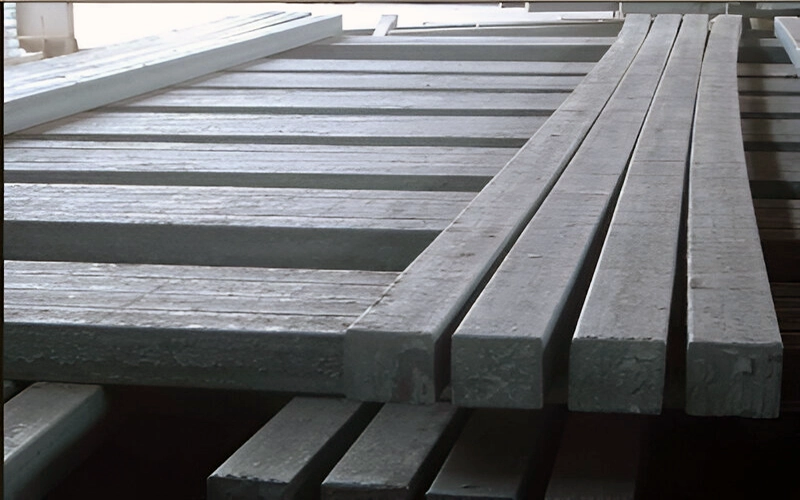A billet is a semi-finished solid metal product that serves as a raw material for various metal processing operations. Typically, billets are square or rectangular in cross-section and can be made from different metals, such as steel, aluminium, copper, or brass. In the steel industry, billets are particularly common and are a crucial intermediate product in the production of structural components and long steel products like rods, bars, and wire.
Billets are usually produced through continuous casting, where molten metal is poured into a mold and then solidified into a long, uniform shape. Alternatively, they can be made through the rolling or extrusion of ingots. Continuous casting has largely replaced traditional ingot casting due to its efficiency, consistency, and better surface quality. The size of a billet can vary depending on its intended application, but in the case of steel billets, a common cross-sectional size is around 100 mm × 100 mm.
Once formed, billets undergo further mechanical working processes such as hot rolling, forging, or extrusion to shape them into final products. These subsequent processes not only define the shape but also enhance the mechanical properties of the metal through controlled deformation and heat treatment.
Billets play a vital role in industries such as construction, automotive, shipbuilding, and manufacturing. For example, in construction, billets are used to make rebar (reinforcing bar), which strengthens concrete structures. In the automotive industry, they are processed into axles, crankshafts, and other essential vehicle components. The versatility and strength of billet-based products make them indispensable across these fields.
One of the key advantages of billets is their uniformity in chemical composition and grain structure, which allows for predictable performance during downstream processing. This consistency ensures high-quality end products with minimal defects.

In recent years, technological advancements have improved the quality of billet production through better temperature control, continuous monitoring, and the use of vacuum-degassing systems to reduce impurities. These improvements contribute to stronger, more durable, and more reliable final products.
In summary, a billet is a foundational component in the metallurgy and manufacturing chain. Its importance lies not only in its role as a basic shape but also in the fact that it ensures the mechanical and structural integrity of the final products made from it.
Billet or Steel Ingot is produced in different sizes and chemical analyses. Ordinary sizes for their cross sections in Iran are 100*100, 120*120, 125*125, 130*130, 140*140,150*150 mm. Ordinary lengths are 1-12 m & the ordinary analysis is as below.
“A billet is a length of metal that has a round or square cross-section, with an area less than 36 sq in (230 cm2). Billets are created directly via continuous casting or extrusion, or indirectly via rolling an ingot, Billets are further processed via profile rolling and drawing

| 3SP | ||||||||
|---|---|---|---|---|---|---|---|---|
| Size | Cr | Cu | C | Si | Mn | P | S | Ni |
| 1.5mm- 10*10&12*12 | 0.3 Max | 0.04 Max | 0.14-0.22% Max | 0.15-0.30 Max | 0.30-0.65% Max | 0.05 Max | 0.04 Max | 0.03% Max |
| 5SP | ||||||||
|---|---|---|---|---|---|---|---|---|
| Size | Cr | Cu | C | Si | Mn | P | S | Ni |
| 1.5mm- 10*10&12*12 | 0.3 Max | 0.04 Max | 0.28-0.37% Max | 0.15-0.30 Max | 0.50-0.80% Max | 0.05 Max | 0.04 Max | 0.03% Max |